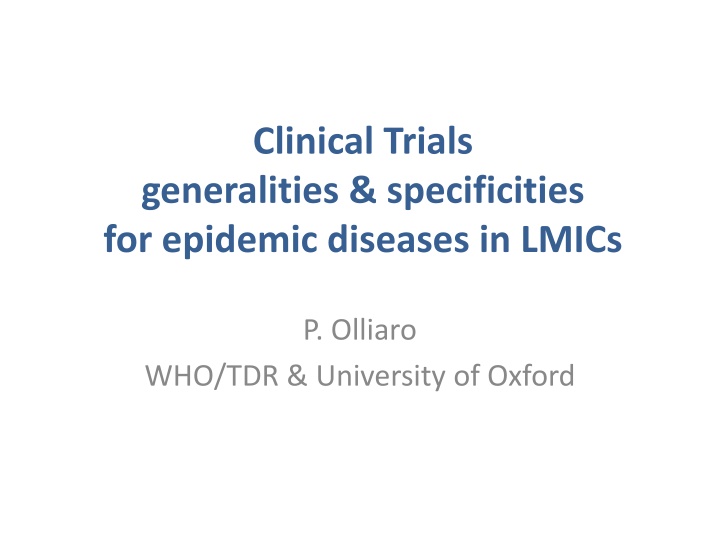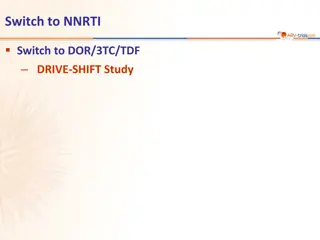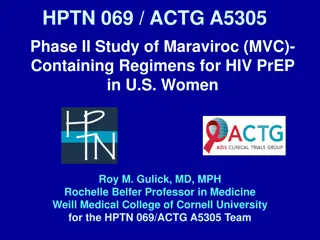
Clinical Trials and Research in Epidemic Diseases: A Comprehensive Overview
This detailed overview delves into the generalities and specificities of conducting clinical trials for epidemic diseases in LMICs, emphasizing post-registration studies, GCP/GCLP requirements, efficacy evaluations, study designs, and the taxonomy of clinical research. The focus is on providing affordable, quality products to address public health priorities amidst outbreaks and challenges, with a mission to support policy, registration, and practice. The content covers phases of clinical studies, regulatory processes, and the importance of sustained clinical research capacities in developing countries.
Download Presentation

Please find below an Image/Link to download the presentation.
The content on the website is provided AS IS for your information and personal use only. It may not be sold, licensed, or shared on other websites without obtaining consent from the author. If you encounter any issues during the download, it is possible that the publisher has removed the file from their server.
You are allowed to download the files provided on this website for personal or commercial use, subject to the condition that they are used lawfully. All files are the property of their respective owners.
The content on the website is provided AS IS for your information and personal use only. It may not be sold, licensed, or shared on other websites without obtaining consent from the author.
E N D
Presentation Transcript
Clinical Trials generalities & specificities for epidemic diseases in LMICs P. Olliaro WHO/TDR & University of Oxford
GCP, GCLP requirements Post- registration studies to inform policy Regulatory Clinical studies (Phase I, II, III) Discovery & Pre-clinical Research First In Humans Policy, Practice Registration Capacities & capabilities for sustained, durable clinical research in Developing Countries
Full scale evalution of treatment efficacy & tolerability Comparative vs. standard treatment (or no treatment) >2 well-conducted studies needed; relatively large numbers Sometimes multi-centre; eligible to meta-analysis First in Humans Clinical Pharmacology & Tolerance (Healthy Normal Volunteers) Determine acceptable single dosage Dose-ranging; dose-escalation Regulatory review process for marketing authorization Phase IV, PMS IND Phase I Phase II Phase III NDA Define tolerability in large numbers when drug used routinely Assess effectiveness in conditions of use Pragmatic trials Investigational New Drug Application Initial clinical investigation for treatment effects Small scale in patients (mild disease) Determine appropriate dose schedule Efficacy, tolerability, PKs
Special features Mission: provide affordable, adapted public health priority products Corollary: provide data in support of registration, policy & practice; availability of quality product Context: Outbreak: challenge & short-window opportunity LMIC capacities & capabilities
Study designs: observational vs. experimental studies What happened? Case-control study What will happen? Cohort study Clinical trial What s happening? Cross-sectional study
TAXONOMY OF CLINICAL RESEARCH Grimes & Schulz, Lancet 2002;359:57-61 Did investigator assign exposures? NO YES Experimental study Observational study Comparison group? Random allocation? Analytical study Descriptive study Randomised controlled trial Non-randomised controlled trial Direction? Exposure & outcome same time Exposure <- outcome Exposure -> outcome Cohort study Case-control study Cross-sectional study
What happened? Case-control study Exposed Cases Non-exposed Exposed Controls Non-exposed Time Onset of study Direction of enquiry
What is happening? Cross-sectional study With oucome Subjects Selected for Study Without outcome Time Onset of study No direction of enquiry
What will happen? Cohort study With outcome Exposed OR Subjects Without outcome Cohort Selected For Study With outcome Unexposed OR Controls Without outcome Time Onset of study Direction of enquiry
Randomised Controlled Clinical Trial With outcome Experimental Subjects Without outcome Subjects Meeting Entry Criteria With outcome Controls (Treated OR Untreated) Without outcome Time Intervention Onset of study Direction of enquiry
type of trial measure population selection bias Randomisation, Blinding, Allocation concealment Randomisation, Rarely blinding, placebo Clinician/patient bias accepted outcome measures intermediate outcomes (understand biological basis) analysis efficacy = benefit under ideal conditions homogenous (entry criteria) evaluability & modified ITT Explanatory effectiveness =benefit in routine practice reflects variation (for generalisability) intent-to-treat (ITT) Pragmatic health gains
Clinical trials & the scientific method Define purpose of trial: state specific hypothesis Design the trial: written protocol Conduct trial: good organization size; avoidance of bias Analyse data: descriptive statistics, tests of hypothesis Draw conclusions: publish results
Some statistic definitions (probability of a type I error) is the probability of erroneously rejecting the null hypothesis (i.e. recommending a medicine with no advantages) given that the null hypothesis is true; (probability of a type II error) is the probability of erroneously failing to reject the null hypothesis (i.e. keeping a good medicine away from patients) given that the alternative hypothesis is true 1- (power) quantifies the ability of the study to find true differences of various values of (see below). It expresses the chance of correctly identifying the alternative hypothesis, and to correctly identifying a better medicine. is the minimum difference between groups that is judged to be clinically important - i.e. the minimal effect which has clinical relevance in case management. Populations of analysis intent-to-treat (ITT): considered the choice population for analysis; all patients randomized who gave informed consent (and received any amount of the assigned intervention at least once). Problem: it requires measurement on all patients whether or not they are still adhering to the protocol ( losses to follow-up ). Used esp. in pragmatic (effectiveness) trials as it reflects treatment effects in conditions that are closer to those encountered in routine use, as opposed to the per-protocol (PP): restricted to the patients without major protocol deviations who are evaluable at the planned visit for efficacy assessment. It measures the pure treatment effect ("evaluable patients' analysis"). Modified ITT (mITT): a subset of the ITT population allowing for the exclusion of patients due to non compliance or missing outcome.
Randomized comparative designs Comparator (reference) intervention Superiority design: to provide evidence that the test intervention is superior to the control COMPARATOR : placebo or active (standard) treatment The study may be designed to compare proportions (cure rates)between the control and test intervention, but also means. A non-significant result (i.e. no significant difference detected) does not imply that the two treatments are equal. SAMPLE SIZE CALCULATION: The choice of the values of type one error rate, , and power, 1- (i.e. how stringent the study will be), and the expected cure rates with the control and the improvement to be detected for the test intervention will determine the sample size of the study. Reliable efficacy data for the comparator arm are needed; wrongly estimating the efficacy of the comparator treatment may result in the study being underpowered, hence failing to produce the intended results. When the number of arms is >2 (i.e. >1 test intervention or dose), this will have to be accounted for in sample size calculation and result in a larger sample size per group, other things being equal, in order to allow for multiple comparisons. Allowance should be made in sample size calculation for losses to follow-up. Read: Chow SC, Liu JP (2004) Hypotheses testing and p-values. Design and analysis of clinical trials Concept and methodologies. second edition ed: Wiley & Sons. pp. 72-73.
The issue of placebo controls Volunteer/provider think they are getting/giving something of value Superiority Design = measures absolute efficacy and safety Measures all pharmacologically mediated effects Cleanly separates drug adverse events from background disease Ethical when no harm can come to the volunteer by no treatment or delayed treatment Placebo controls with design modification: Add on Replacement Early Escape Limited Placebo Period Randomized Withdrawal Unbalanced Randomization
No-treatment arm True negative controls Disadvantages Cannot be fully blinded Subject retention Patient management All aspects of observation Critical decisions made by observer blinded to Rx assignment Eligibility Endpoint determination Changes in management
Sample size calculations for comparative superiority trials Control treatment Success Rate 0.6 0.6 0.6 0.6 0.6 0.6 0.6 0.6 0.6 0.6 0.6 0.6 0.65 0.65 0.65 0.65 0.65 0.65 0.65 0.65 0.65 0.65 0.65 0.65 0.7 0.7 0.7 0.7 0.75 0.75 0.75 0.75 0.75 0.75 0.75 0.75 0.8 0.8 0.8 Test treatment Success Rate Power N Per Group 0.7 0.7 0.7 0.7 0.8 0.8 0.8 0.8 0.9 0.9 0.9 0.9 0.7 0.7 0.7 0.7 0.8 0.8 0.8 0.8 0.9 0.9 0.9 0.9 0.8 0.8 0.8 0.8 0.8 0.8 0.8 0.8 0.9 0.9 0.9 0.9 0.9 0.9 0.9 0.80 0.85 0.90 0.95 0.80 0.85 0.90 0.95 0.80 0.85 0.90 0.95 0.80 0.85 0.90 0.95 0.80 0.85 0.90 0.95 0.80 0.85 0.90 0.95 0.80 0.85 0.90 0.95 0.80 0.85 0.90 0.95 0.80 0.85 0.90 0.95 0.80 0.85 0.90 356 407 477 589 82 93 109 134 32 36 42 52 1377 1575 1842 2278 138 158 185 228 43 49 57 70 294 336 392 485 1094 1251 1464 1810 100 114 133 164 199 228 266
Randomized comparative designs Comparator (reference) intervention Non-inferiority design: to show the new intervention is no worse than the standard treatment by some margin (the non-inferiority margin) = the largest clinically acceptable difference Choice of the non-inferiority margin: avoid harmful treatment to be declared non-inferior, and to retain a treatment that brings a true benefit for the patient. The decision should be based on previous studies with the reference treatment and the minimally important effect that one wants to observe with the new treatment against additional benefits. How to identify the correct , E.g. compare (i) the two-sided 95% confidence interval of the difference between the test and the reference treatment to (ii) a two-sided 95% CI of the difference between the reference treatment and the placebo based on historical data and meta analyses (if such data are available). also consider a clinically acceptable failure rate, in the context of other factors, e.g. duration of treatment, route of administration, costs. Populations analysed Traditionally PP because ITT might bias the results toward equivalence (risk of falsely claiming non- inferiority). Current thinking and regulatory agencies demand: the study objective should be achieved in both the ITT and PP populations Minimise losses to follow-up! Rothmann M, Li N, Chen G, Chi GY, Temple R, et al. (2003) Design and analysis of non-inferiority mortality trials in oncology. Stat Med 22: 239-264. Hasselblad V, Kong DF (2001) Statistical methods for comparison to placebo in active control trials. Drug Information Journal 35: 435- 449
Sample size calculations for comparative non-inferiority trials Non- Reference treatment Success Rate N Per Group inferiority margin -0.05 -0.05 -0.05 -0.05 -0.06 -0.06 -0.06 -0.06 -0.07 -0.07 -0.07 -0.07 -0.08 -0.08 -0.08 -0.08 -0.09 -0.09 -0.09 -0.09 -0.1 -0.1 -0.1 -0.1 0.80 0.85 0.90 0.95 0.80 0.85 0.90 0.95 0.80 0.85 0.90 0.95 0.80 0.85 0.90 0.95 0.80 0.85 0.90 0.95 0.80 0.85 0.90 0.95 1667 1328 938 495 1158 923 651 344 851 678 479 253 651 519 367 194 515 410 290 153 417 332 235 124 Efficacy in the reference arm from 80%-95%, delta 5-10%, alpha error 0.01, power 90% Non-inferiority margin = the smallest acceptable difference with respect to the success rate with the reference treatment.
Sample size calculation (N per group) for non-inferiority trials reference treatment success rate 65% 70% 75% 1646 1519 1356 1728 1595 1424 1811 1671 1492 1893 1747 1559 1975 1823 1627 2058 1899 1695 926 855 972 898 1019 941 1065 983 1111 1026 1158 1069 593 547 623 574 652 602 682 629 712 656 741 684 delta exclusions 0% 5% 10% 15% 20% 25% 0% 5% 10% 15% 20% 25% 0% 5% 10% 15% 20% 25% 60% 1736 1823 1910 1996 2083 2170 977 1026 1075 1124 1172 1221 625 656 688 719 750 781 80% 1158 1216 1274 1332 1390 1448 651 684 716 749 781 814 417 438 459 480 500 521 85% 923 969 1015 1061 1108 1154 519 545 571 597 623 649 332 349 365 382 398 415 90% 651 684 716 749 781 814 367 385 404 422 440 459 235 247 259 270 282 294 6% 763 801 839 877 916 954 489 513 538 562 587 611 8% 10% Success rate ranging 60-90%; exclusions ranging 0-25%; non-inferiority margin (delta) 6%, 8% and 10%
Adaptive designs Meant to allow choices amongst various drugs and regimens (dose, duration) systematically, as quickly and effectively and with as few patients as possible. Includes: group sequential designs, sequential methods and methods to stop earlier trials with superiority or non-inferiority designs. Allow redesigning the trial based on the information acquired through interim analyses, which may result in changing the sample size, the number of arms, or other elements. Sequential and group-sequential trials are a special case of adaptive trials where several interim analyses are done in order to complete earlier the trial based on the accumulated information.
Adaptive designs: sequential methods Whitehead triangular test: a graphical methods defining with boundaries which allows for early rejection or non-rejection of H0. most effective when early end-points or surrogate markers exist requires an efficient (on-line) data-management system in place and a constant interface with a statistician. allows analysing cumulated information at each step, early stopping (when treatment proves effective (p0) or ineffective (pa)), non-comparative and comparative designs, and can eventually result in shortening study duration and reducing the number of subjects to be exposed. several treatments (or doses) can be tested in parallel. allows combining sequentially in a single study: (1) screening of potential treatments (one-sided triangular test applied to multiple non-comparative studies as required) and (2) comparing the so selected treatment to the reference treatment (two-sided triangular test)
Boundaries of the one-sided triangular test pa = 0.20 pa=0.18 pa = 0.25 example of sequential analyses with modeled data
Sample size calculation for the one-sided and two-sided triangular test one-sided Pa = 0.20 Cumulated informatio n Z statistic 7 14 20 27 34 40 47 54 60 67 two-sided Pa = 0.20 Cumulated informatio n Z statistic 8 16 24 32 40 48 56 64 72 79 Pa = 0.18 Cumulated informatio n Z statistic 8 16 24 32 40 48 56 64 72 80 Pa = 0.25 Cumulated informatio n Z statistic 5 10 14 19 23 28 32 37 41 46 N per group N per group N per group N per group Stage 1 2 3 4 5 6 7 8 9 27 55 82 110 137 165 192 220 247 274 23 47 67 90 16 31 44 60 72 88 101 117 129 145 27 53 80 107 133 160 187 213 240 263 113 133 157 180 200 223 10 pa=0.18, 0.20 and 0.25; and two-sided test, pa=0.20
Study flow diagram and patient attrition according to the CONSORT statement


















![[Insert Study Name] Study Webinar: Engaging Participants for Research Progress](/thumb/168084/insert-study-name-study-webinar-engaging-participants-for-research-progress.jpg)



